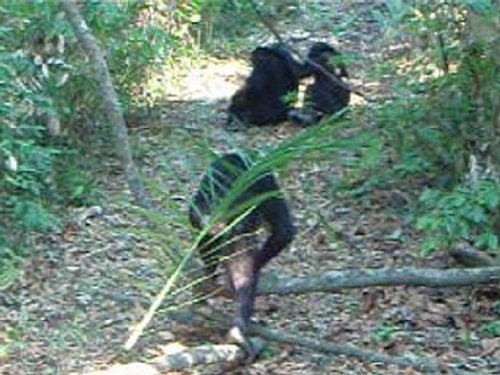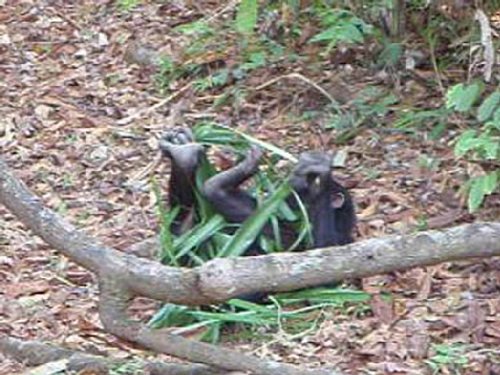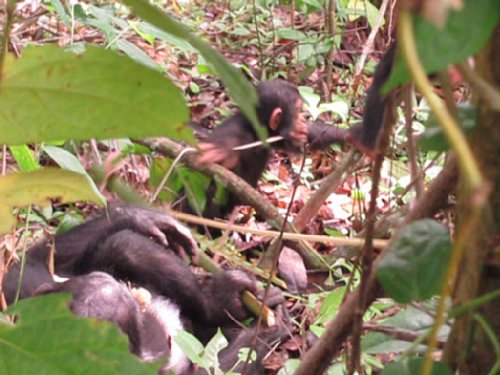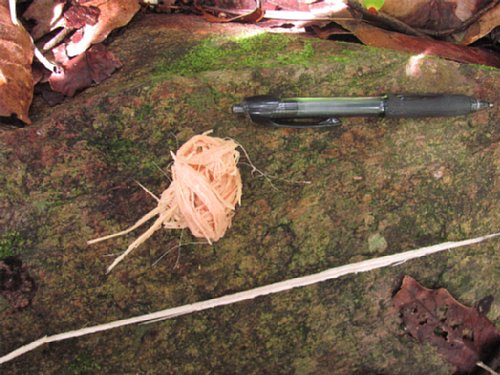|
<NOTE>
Mahale Chimpanzees Start to Eat Oil Palm
Koichiro Zamma1,3, Mai Nakashima2,3 & Abdala Ramadhani3
1 Great Ape Research Institute, Hayashibara Biochemical Laboratories, Inc., Japan 2 Wildlife Research Center, Kyoto University, Japan 3 Mahale Mountains Chimpanzee Research Project INTRODUCTION The oil palm (Elaeis guineensis) is a cultural food of wild chimpanzees1. The Gombe chimpanzees in Tanzania eat the pericarp of its fruit, the pith of its fronds, its flowers, and its wood2. The Bossou chimpanzees in Guinea eat its pericarp, the base of its fronds, and its wood as well as its nut kernel (accessing it using stone hammers and anvils)3 and its apical meristem (by pounding it with a pestle-like leaf-petiole)4. In contrast, the Semliki chimpanzees in Uganda appear not to eat any part of the oil palm5. Researchers have observed the Mahale chimpanzees in Tanzania since the 1960s and have not observed these chimpanzees eating any part of the oil palm6,7, but in 2010 they started to eat the pith of the oil palm. This paper presents two observations of oil palm eating and discusses the triggers for this behavior. METHODS We studied the chimpanzees in Mahale Mountains National Park, Tanzania8, from July 7 to December 4, 2010 (MN), and from December 5, 2010, to January 18, 2011 (KZ). AR supported MN and KZ as a field assistant. We observed M group chimpanzees (total observation time of MN is 410.9 hr and that of KZ is 184.5 hr) but were not focused specifically on oil palm-eating behavior. We used the ad libitum sampling method9 when chimpanzees were eating parts of the oil palm. OBSERVATIONS Case 1 On August 23, 2010, MN and AR followed Darwin, an adult male, who joined a party with 15 individuals. At 09:56, some chimpanzees fought in a bush, and at 10:22, Darwin walked from the bush to an observation trail. MN and AR followed him, and AR cut a frond of oil palm that was in the way with a machete. At 10:25, Mitsue, a 9-year-old female, and Michio, a 14-year-old male and a brother of Mitsue, came from the bush to the observation trail. Michio started to groom Darwin, and Mitsue picked up the cut frond and transported it on her back (Figure 1). The frond was 160 cm long and was cut at one end. At 10:27, Mitsue lay down on the frond, and then broke the stem of the frond, stripped the rind from the frond with her teeth and hand, split the pith of the frond, and chewed the pith (Figure 2). At 10:31, Mitsue was still chewing the wadge, but Darwin and Michio did not appear to be interested in her behavior. At 10:36, she split the pith again and chewed it for about 40 seconds. Then she lay down on the ground. 
Figure 1. Mitsue transports an oil palm frond cut by a human. 
Figure 2. Mitsue lies down on the oil palm frond and chews its pith. At 10:40, Mitsue got up and transported the frond on her back. Then she placed it on her neck, walked about 2 m, and sat on the ground hugging it. At 10:48, Darwin, Michio, and Mitsue moved and left the remaining frond on the ground. Case 2 On January 15, 2011, KZ and AR observed a party consisting of 10 chimpanzees including Mitsue (four adult females, one adult male, one young female, one young male, two infant females, and one infant male). Four tourists with a park ranger and a tourist guide were also watching them. At 10:43, another two tourists with a park ranger and a tourist guide appeared after the preceding tourist group left. After 20 minutes, the park ranger cut several mature oil-palm fronds with a machete to make way for the approaching chimpanzees. At 11:17, Mitsue picked up and transported a piece of the frond cut by the ranger. The piece was 90 cm long and was cut at both ends. Mitsue sat on the ground and licked the end that was wet with sap. At 11:26, she stripped the rind from the frond with her teeth and hand, split its pith, and chewed the pith. Two infant females, Lilim (three years old) and CY08 (two years old), approached and watched Mitsue chewing the wadge of pith. At 11:29, Lilim started to split the pith of the frond held by Mitsue. Mitsue continued chewing her wadge and allowed Lilim to take it, but CY08 snatched the fragment of pith split by Lilim (Figure 3). CY08 climbed a tree, put the pith into her mouth, and chewed it. At 11:30, Mitsue split the pith again and chewed it. Lilim approached Mitsue and tried to take the pith from her again, but Mitsue would not allow her to take it. 
Figure 3. CY08 (right) takes a piece of oil palm frond pith. Mitsue (left) keeps the oil palm frond. At 11:33, the party left the area and the wadge remained on the ground (Figure 4). KZ tasted another piece of frond cut from the same area; it was insipid. 
Figure 4. Wadge remained on the ground. DISCUSSION Local people living near Mahale eat some parts of the oil palm. They make cooking oil from the pericarp, make alcohol from the tree’s sap, and eat the kernel of the oil palm. The local people use stone hammers and anvils, and these tools with cracked nuts and kernels, which were used by local people, were observed in the home range of the M group of chimpanzees in 2000 (KZ personal observation, Figure 5) and in 1996 (W. C. McGrew personal communication). The pericarp is also eaten by yellow baboons (Papio cynocephalus) and red-tailed monkeys (Cercopithecus ascanius), which are common diurnal monkeys in Mahale. Thus, the oil palms in Mahale are edible, and the Mahale chimpanzees have the opportunity to learn to eat parts of the oil palm from other species, but they have not previously been observed doing so. 
Figure 5. A stone hammer and anvil used by local people in the home range of the M-group. Cracked nuts and the kernels are scattered around the anvil. This picture was taken in 2000. No animals or humans in the Mahale Mountains have been observed eating the pith of the oil palm, so Mitsue may be a pioneer. Chimpanzees in Gombe and Bossou have been observed eating the pith of the oil-palm frond, but they used a different feeding technique than that used by the Mahale chimpanzees. The Bossou chimpanzees pull or break a young soft frond from and eat its base on the top of oil palm tree or on the ground (G. Ohashi personal communication). The Gombe chimpanzees also eat young fronds using their hands and mouth (S. Kamenya personal communication). In contrast, the Mahale chimpanzees do not climb the oil palm tree or pull out fronds. Mitsue was observed picking up fronds from the ground after they were cut by humans; neither Gombe or Bossou chimpanzees have been observed eating the pith of a frond cut by a human (S. Kamenya and G. Ohashi personal communication). It is remarkable that human activity inspired chimpanzees to try a new food item even though it was unintentional. People working in Mahale must cut many plants that are in the way, but chimpanzees do not pay particular attention to most cut plants even when they are edible. Mitsue was unusually curious especially about objects and picked up various items from the ground regardless of whether they were edible (Table 1). The cut frond might have just been one of these items to transport, and she may have discovered incidentally that it was edible. Table 1. Items transported by Mitsue during 18 days of observation from December 5, 2010, to January 18, 2011. 
A cut frond of an oil palm is uninteresting to most of chimpanzees, but after Mitsue began to pay attention to it, infant females also started to take notice of it. Most of novel behavioral patterns have not spread to many other individuals7, so it is difficult to predict whether this novel food item will become a cultural food for the Mahale chimpanzees. A follow-up survey will be required. ACKNOWLEDGEMENTS We thank TAWIRI, TANAPA and COSTECH for permission to do the field research, and MMNP and MMWRC for logistic support. We also thank Dr. William C. McGrew, Dr. Shadrack Kamenya and Dr. Gaku Ohashi for valuable comments and Dr. Toshisada Nishida for his kind support. This study was financially supported by the Grant-in-Aid for Scientific Research (A) (#19255008 to T. Nishida) and ITP-HOPE (Primate Origins of Human Evolution) program of JSPS. REFERENCES
Back to Contents |